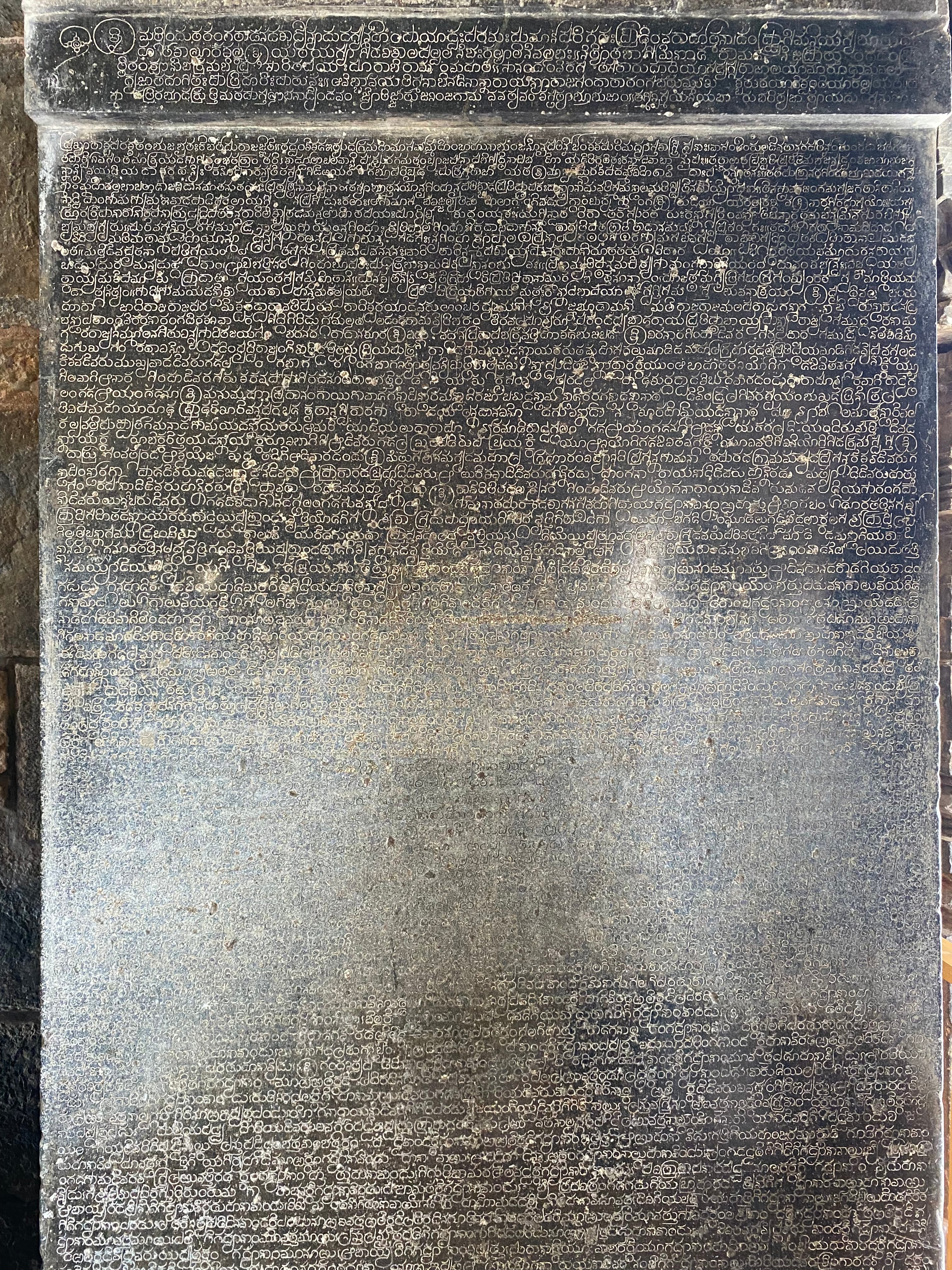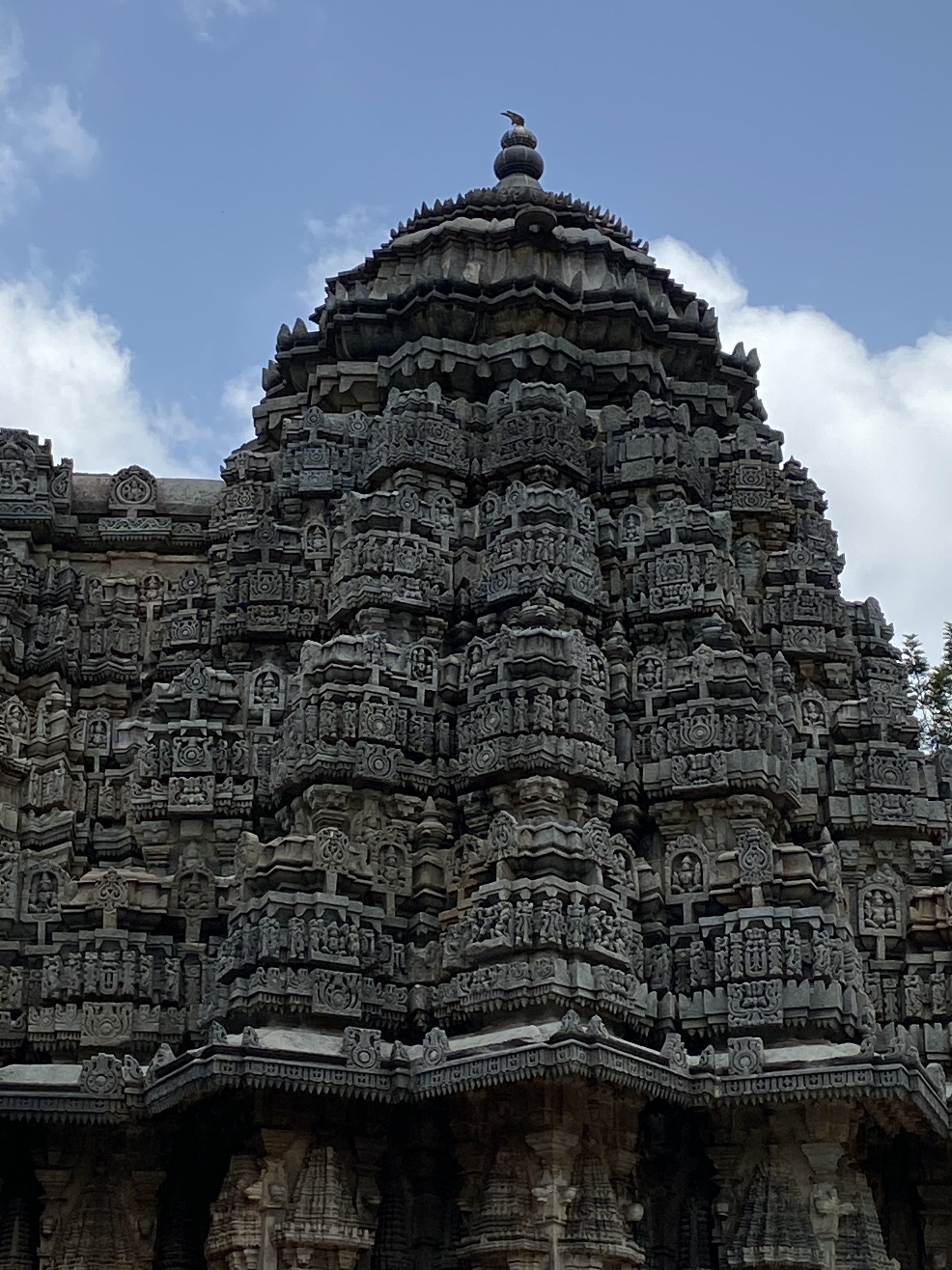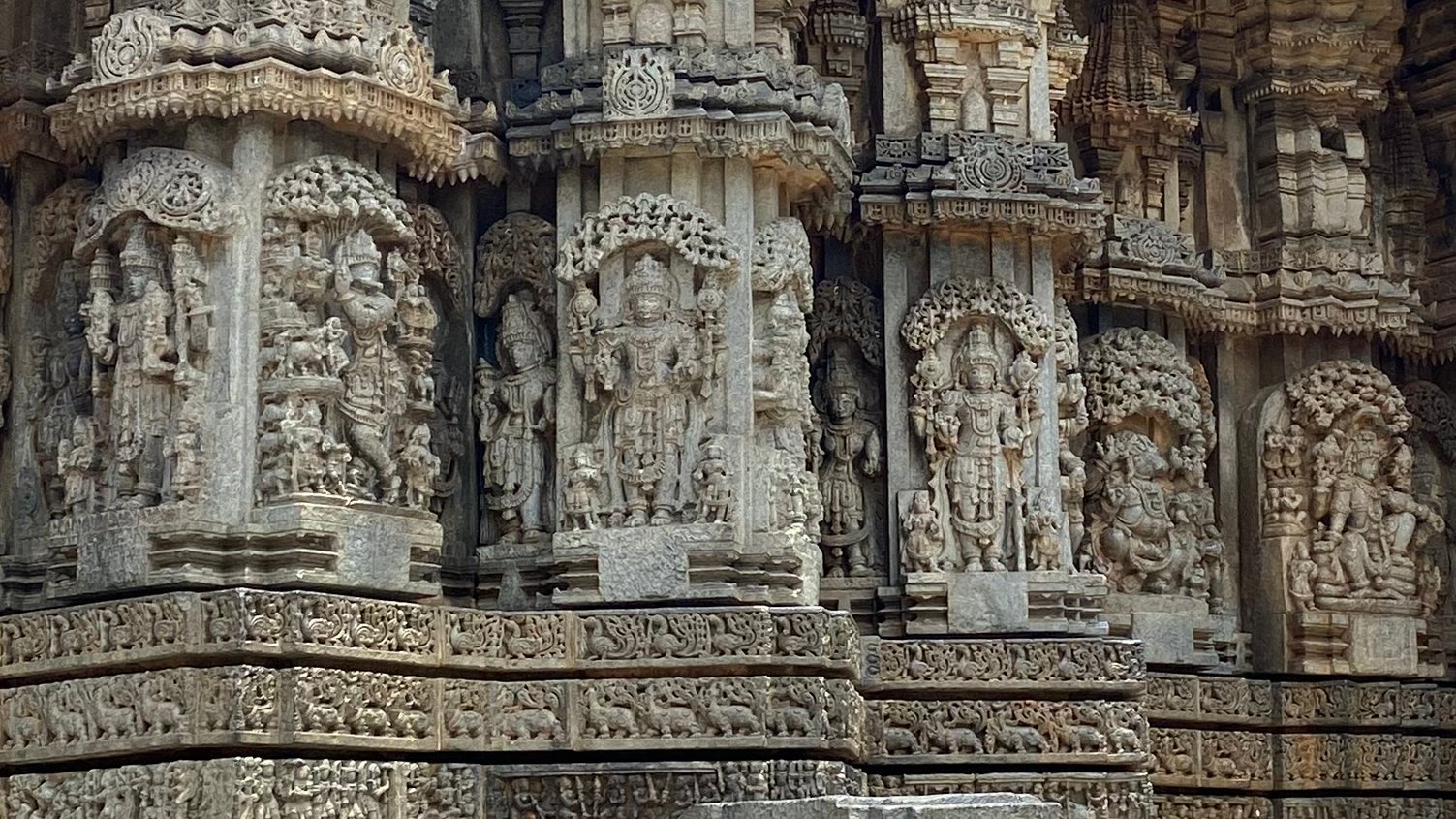 |
| Chennakeshava Temple, Somanathapura, Karnataka |
A detailed post on the history, architecture & sculpture of the Hoysala built Chennakeshava Temple at Somanathapura, Karnataka. This is going to be a long one & it took me a while to piece all the information together. Do continue reading till the end. Lets's begin.
The Keshava temple was constructed by Somanatha Dandanayaka on receiving funds from reigning King Narasimha III. This temple was consecrated in 1238 CE & is considered the last major temple building activity undertaken by the Hoysalas.
Inscription issued by Hoysala king Narasimha III
 |
| Inscription |
In front of the entrance of the temple is a 10mt high Dipasthambha. The Temple is enclosed in a prakara wall & is entered through a mantapa on the east. To the left of this mantapa is a 3mt high slab with inscription in both Kannada & Sanskrit dating to the reign of Narasimha.
The 1st inscription has 91 lines & is in old Kannada script in both Kannada & Sanskrit. It registers a gift of 3000 pieces of gold by king Narasimha for the worship of Keshava. The next 3 inscriptions are all in Kannada & relates to land grants, temple revenue etc
Architectural Elements of a Hoysala Temple
 |
The Keshava temple is regarded as one of the most perfectly designed Trikutachala (triple celled) temple. The main temple stands on a Jagati (Platform) and follows a stellate (star shaped) floor plan. I have labelled the different architectural elements of the temple
1) Jagati (Base)
 |
| Jagati |
The Jagati at around 3 ft in height serves as the Pradishhana patha. As one walks in a clockwise manner, we can pictorially read stories from Ramayana, Mahabharata & Bhagavata Purana. We will look at these carvings in detail later
2) Adhisthana (Plinth)
 |
| Adhisthana |
Here we can see 6 tiered frieze(Kapota-bandha) beginning from the lowest, a row of elephants. Then cavalry with horsemen. Followed by foliated creepers. This followed by scenes from Purana-Itihasa. Followed by friezes of Makara & Hamsa
3) Bhitti (Wall)
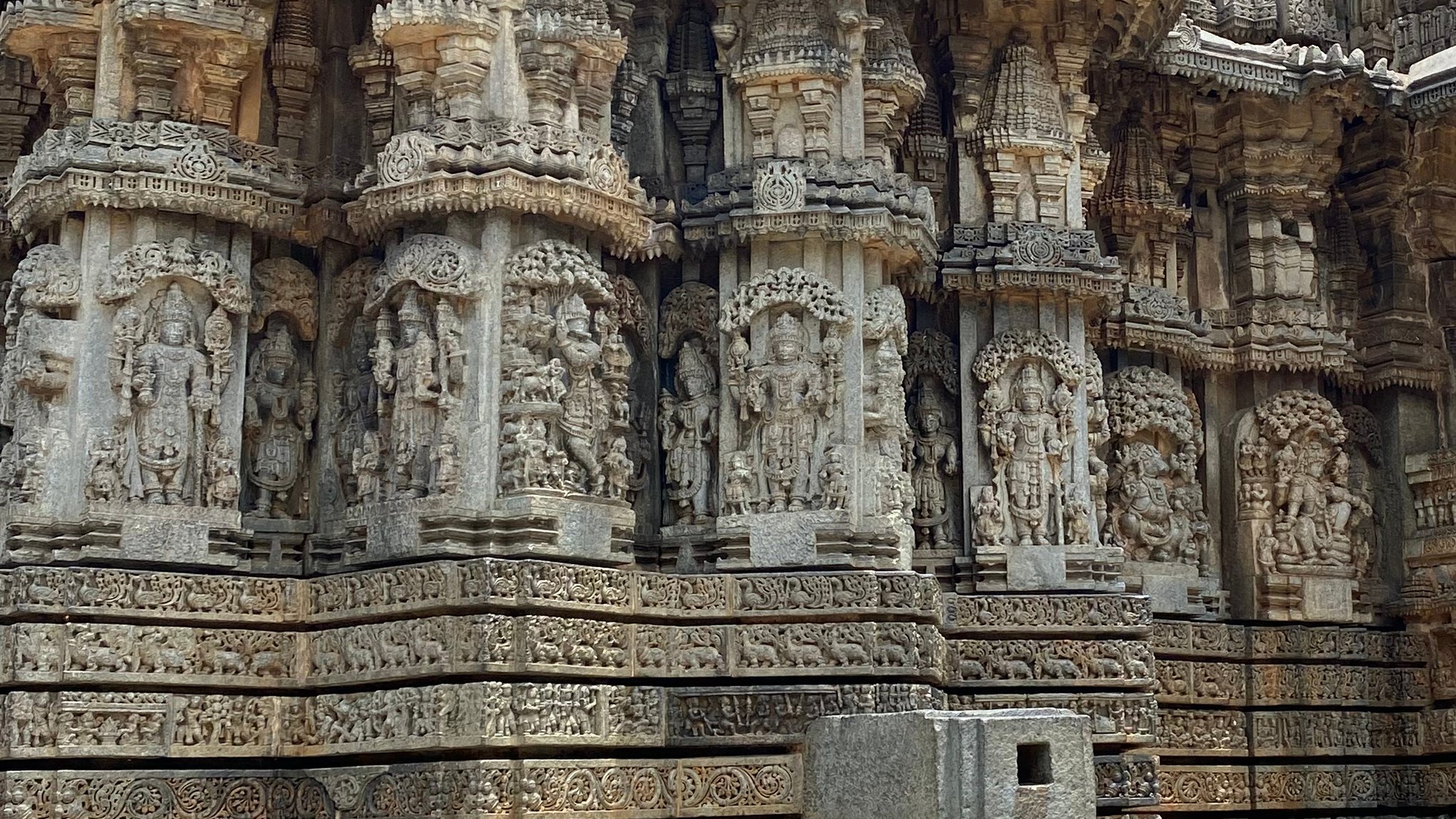 |
| Bhitti |
The wall portion of temple is known as Bhitti. The Bhitti has sculptures of Devatas, Gandharvas, Rishis etc. There are nearly 200 sculptures on the Bhitti, all of which will be thoroughly examined in this post. It includes Chaturvimsati Vishnu(24 forms of Vishnu)
4) Kakshasana
 |
| Kakshasana |
The last course of the Adhistana support the Kakshasana of the porch balcony seating. The sloping external surface of the Kakshasana is decorated with stories from the Puranas including that of Bhakta Prahalada. We'll explore these carvings later
5) Jalandhrakas (Windows)
 |
| Jalandhrakas |
 |
| Jalandhrakas |
Above the Kakshasana, decorative stone screens (jalandhrakas) enclose the mantapa inside which allow diffused light into the inner spaces. The decorative patterns were added during the time of Veera Ballala III. There are 20 such windows in total.
6) Chadya
 |
| Chadya |
The Chadya that runs along the entire Temple acts as a separation layer between the Bhitti & the main Shikhara. The Chadya features numerous miniature Shikharas positioned just above the Bhitti sculptures.
7) Shikhara
 |
| Shikara |
Each of the 3 Shikharas of the temple is elaborately but very similarly designed. Each is built in the plan of a 16 pointed star. There are carvings of Simhamukhas, Kirtimukhas, Makaras, Yakshas, Gandharavas.
Wall Sculptures
Now lets have a look at the exquisite wall sculptures. There are around 200 murthis. We'll attempt to identify them all. Some of the sculptures also bear names of the Sthapatis who sculpted them. Some them include Mallitamma, Chaudiah, Baliah, Masanitamma, Lohita, Elemasiah..
1) Vaikuntanarayana
2) Tandava Ganapathi
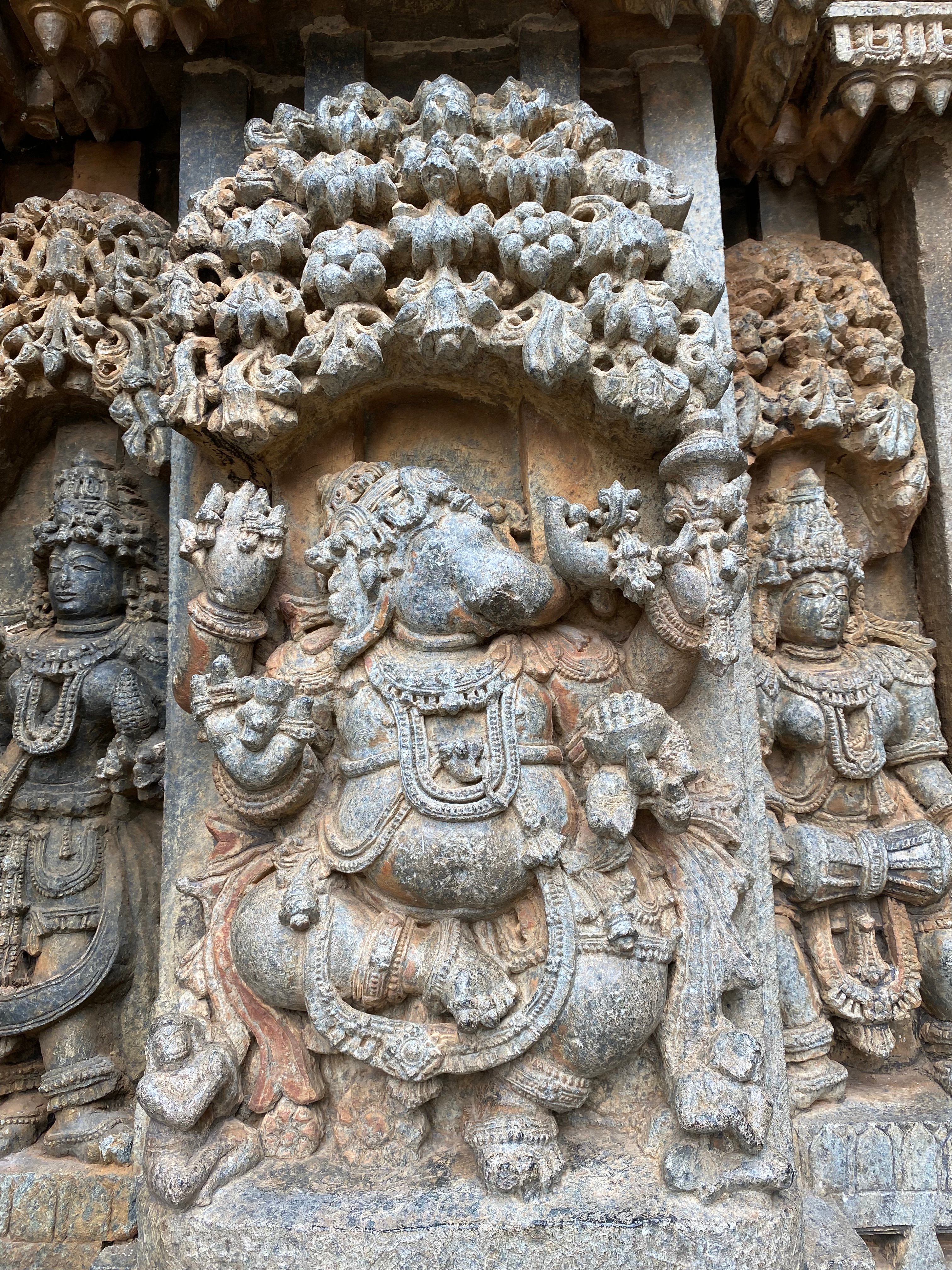 |
| Ganesha dancing. He is seen holding an ankusha, svargahasta, padma, apuupa bowl. There is a Apsara playing the Dhavane (percussion) on his left |
3) Nritya Sharadha/Saraswati
4) Janardhana
 |
| This is one of the 24 forms of Vishnu. He holds an Akshamala, Chakra,Shanka & a Phala. Also seen to the right is Lakshmi |
5) Keshava
 |
| Yet another one of the 24 forms of Vishnu. He has 6 hands, holding a gada, padma, shanka, chakra, paasa, dhana. Lakshmi is seen to the left |
6) Keshava
 |
| He holds Phala instead of gada. But its broken. Lakshmi is seen to the right. Baliah has been identified as the sculptor of this image |
7) Venugopala
8) Krishna
 |
| One of the 24 forms of Vishnu. Seen holding Shanka, gada, padma, chakra |
9) Indra
 |
| He is standing in samabhanga & has 4 objects bearing in each hand. Shanka & Chhakra in the upper hand. Vajra & Danda in his lower hands |
10) Rama
 |
| Vishnu as Rama with 6 hands, holding arrow, chakra, padma, shanka, gada & a patra. The maker of this image is identified as Bomma |
11) Prasanna Raghava
 |
| Vishnu with 6 hands. Seen holding Abhaya mudra, shanka, arrow, bow, padma & dhanus |
12) Varuna
 |
| Vasudeva as Varuna with 6 hands each holding padma, chakra, ankusha, paasa, shanka, phala. The pitha below has the inscription "Sa ni raa ra" |
13) Yoganarayana/Badrinarayana
 |
He is seated in Padmasana, his back hands holding Shanka & chakra. Front hands are in yogamudra |
14) Nritya Lakshmi
15) Sankarshana
16) Shridhara
 |
| Wields chakra, gada, shanka & padma in each one of the 4 hands. Related to 24 forms of Vishnu. Sculptor of this murthi is Mallitamma |
17) Brahma
18) Vishnu
 |
| Standing with abhaya, chakra, shanka, dana |
19) Dhanavantri
 |
| Seated in padmasana holding Kalasha & Apupa |
20) Brahmani
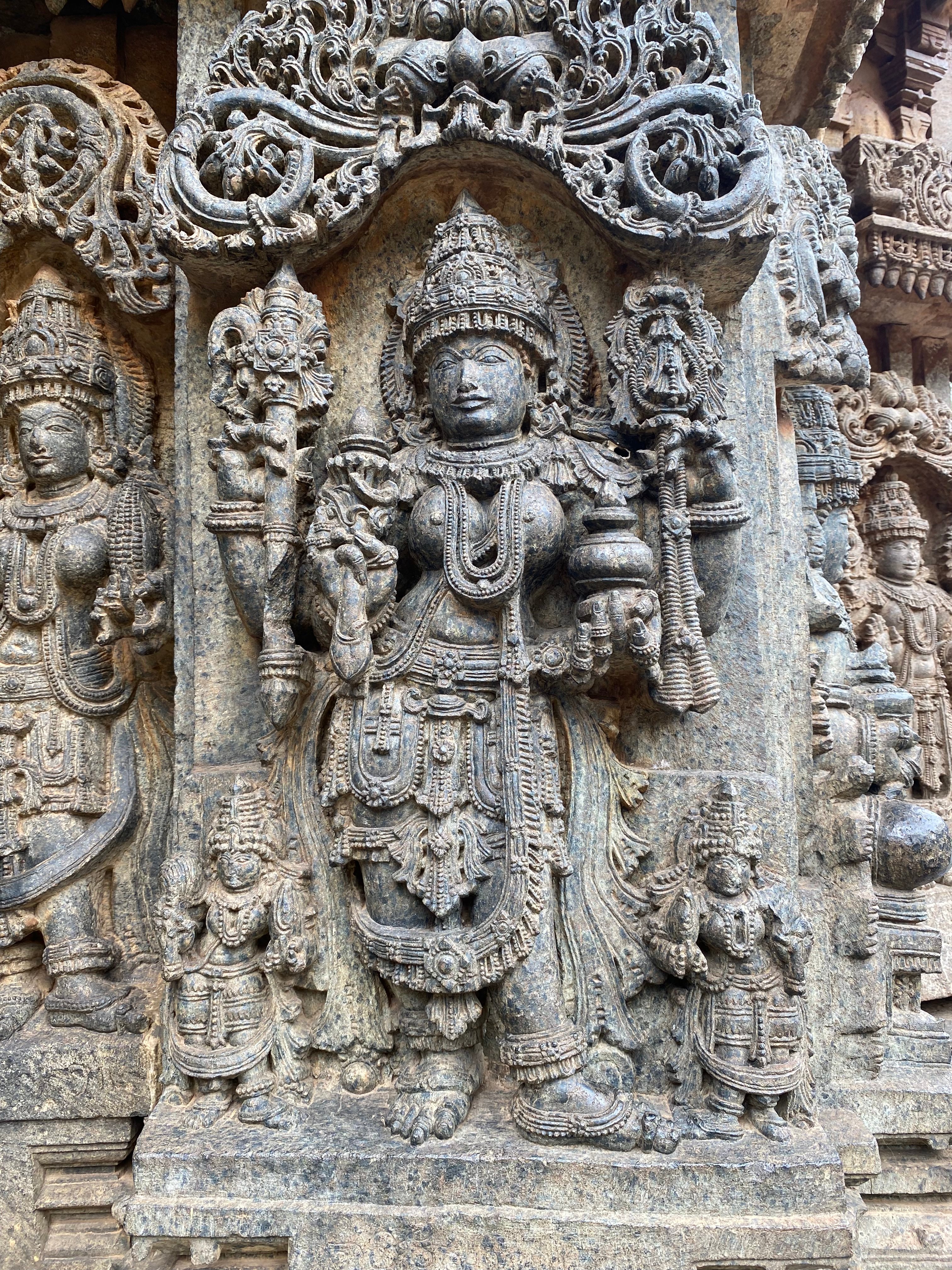 |
| She is seen standing with 4 hands, each holding padma, ankusha, pasha, kalasha |
21) Matsya avatara of Vishnu
 |
| Vishnu with the face of a fish standing with 6 hands out of which one is broken. The rest hold Shanka, padma, gada, chakra & maala |
22) Varaha
 |
| Vishnu with the face of a boar. Has 6 hands, each holding chatri (umbrella), chakra, shanka, padma & phala (broken) |
23) Kurma
 |
| Vishnu with the face of a tortoise. Highly damaged. Back hands hold chakra & shanka. Front hands hold what is believed to be the Mandara parvata |
24) Parijata-apaharana
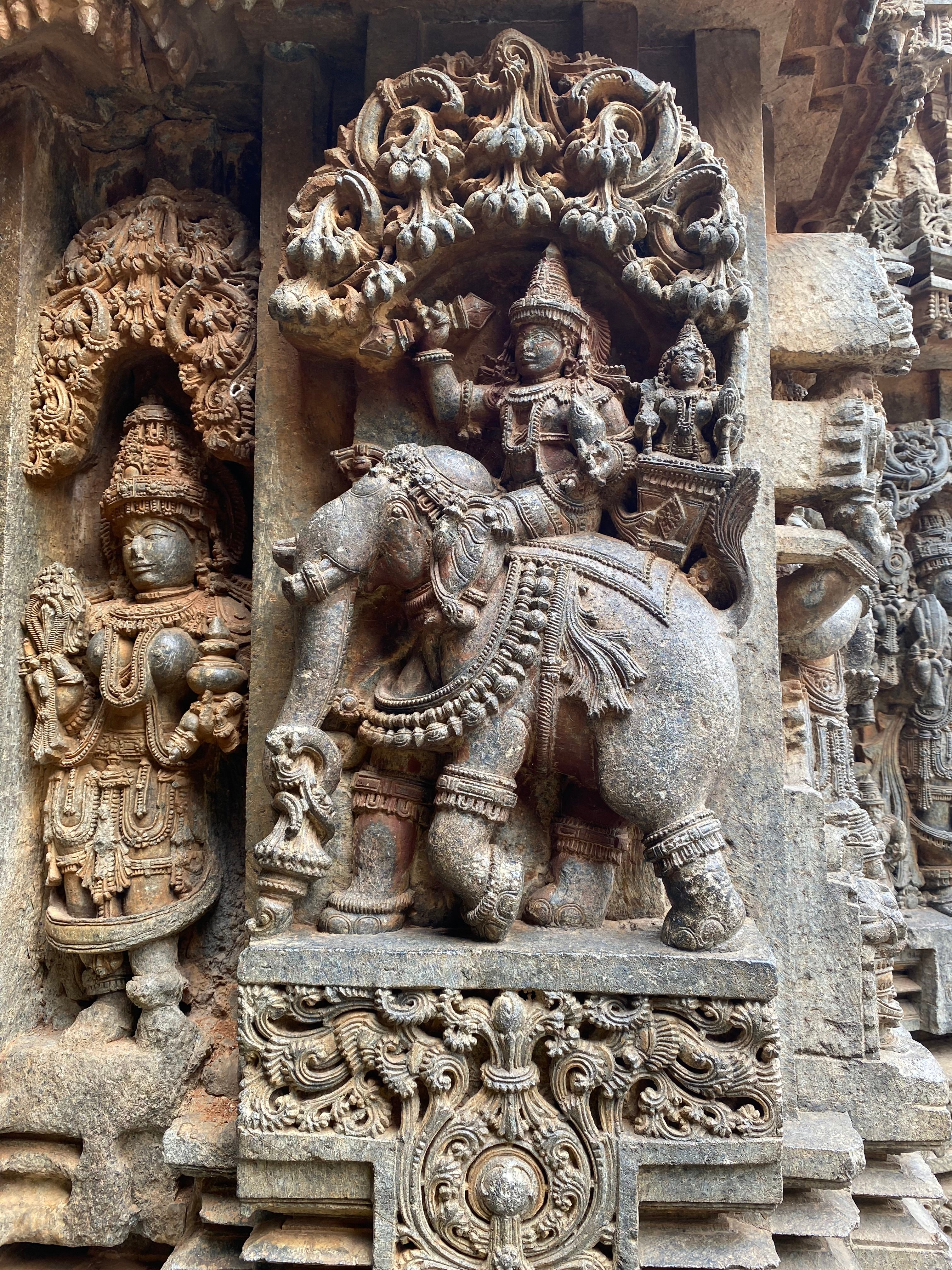 |
| Indra & Sachi seated on the Airavata elephant defending against Krishna & Satyabhama (next image) in order to prevent the latter from carrying away the Parijata tree |
25) Garuda, Krishna & Sathyabhama
 |
| Krishna & Satyabhama riding on the shoulders of Garuda carrying away the Parijata tree |
26) Lakshmi Narasimha
 |
| Narasimha seated in sukhasana with Lakshmi sitting on his lap. Prahalada is also seen to his right with folded hands |
27) Vishnu
 |
| Difficult to identify which form of Vishnu this is as all the arms are broken. The stapathi who made this is Vitthala |
28) Vishnu
 |
| Standing with one hand in Daana. The other 3 are broken. Lohita is the sculptor of this image |
29) Nritya Sharadha
 |
Saraswathi with 6 arms in dancing posture. Each holding Veena, ankusha, akshamala, pustaka, paasha. Sculptor has been identified as Talamasayya |
30) Janardhana
 |
| Lower right hand broken, Chakra, Shanka & Varadamudra |
31) Vishnu
 |
| 3 arms broken, one holding Shanka. Difficult to tell which form |
32) Vishnu
 |
| Only a bow can be partially identified. Difficult to tell which form |
33) Harihara
 |
| 6 armed Harihara. Trishula & Padma partially visible. Rest all broken |
34) Vishnu
 |
| Only padma visible. 3 hands broken |
35) Vishnu
 |
| Only Shanka visible. 3 hands broken |
36) Vishnu
 |
| Chakra & Musala visible. 2 arms broken |
37) Trivikrama
 |
| 4 armed Trivikrama. each seen holding Abhayamudra, musala, chakra & shanka |
38) Parashurama
 |
| Seen in each of the 4 arms are padma, parashu, chakra & musala |
39) Halayudha
 |
| Vishnu holding chakra, hala (plough), musala & daana |
40) Sankarshana
 |
| Holding padma, hala, musala. Another object is not identifiable |
41) Vishnu
 |
| 3 arms seen. 1 broken. rest 3 hold chinmudra, shanka & musala |
42) Harihara
 |
| 8 armed. 4 broken. Rest hold sarpa, shanka, ankusha & varadamudra |
43) Vishnu
 |
| Back hands holding chakra & shanka, front arms in anjali mudra |
44) Vishnu
 |
| 4 armed. One damaged. Each holding musala, shanka, chakra |
45) Vishnu
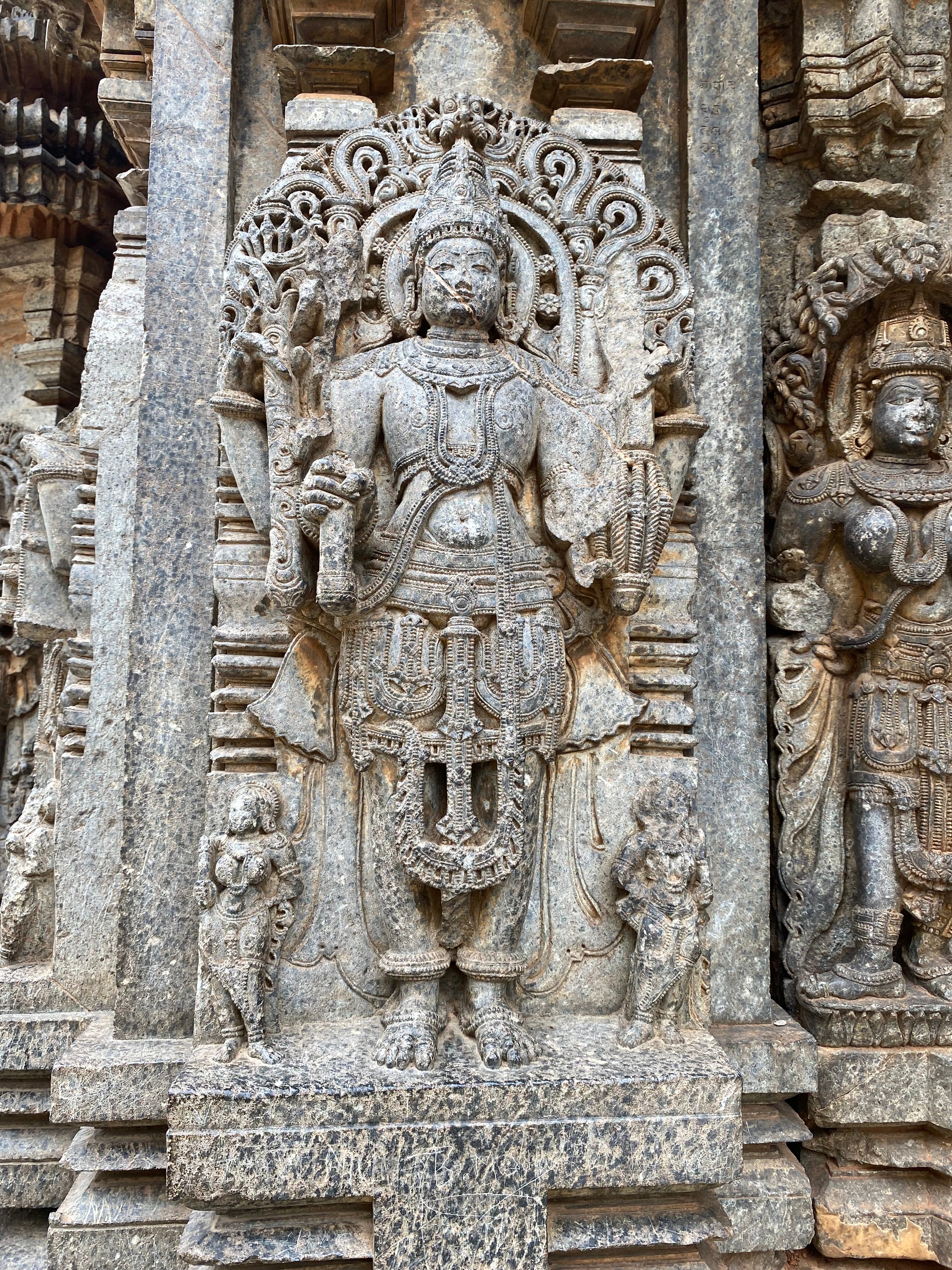 |
| Heavily damaged. Padma & gada are partially visible |
46) Vishnu
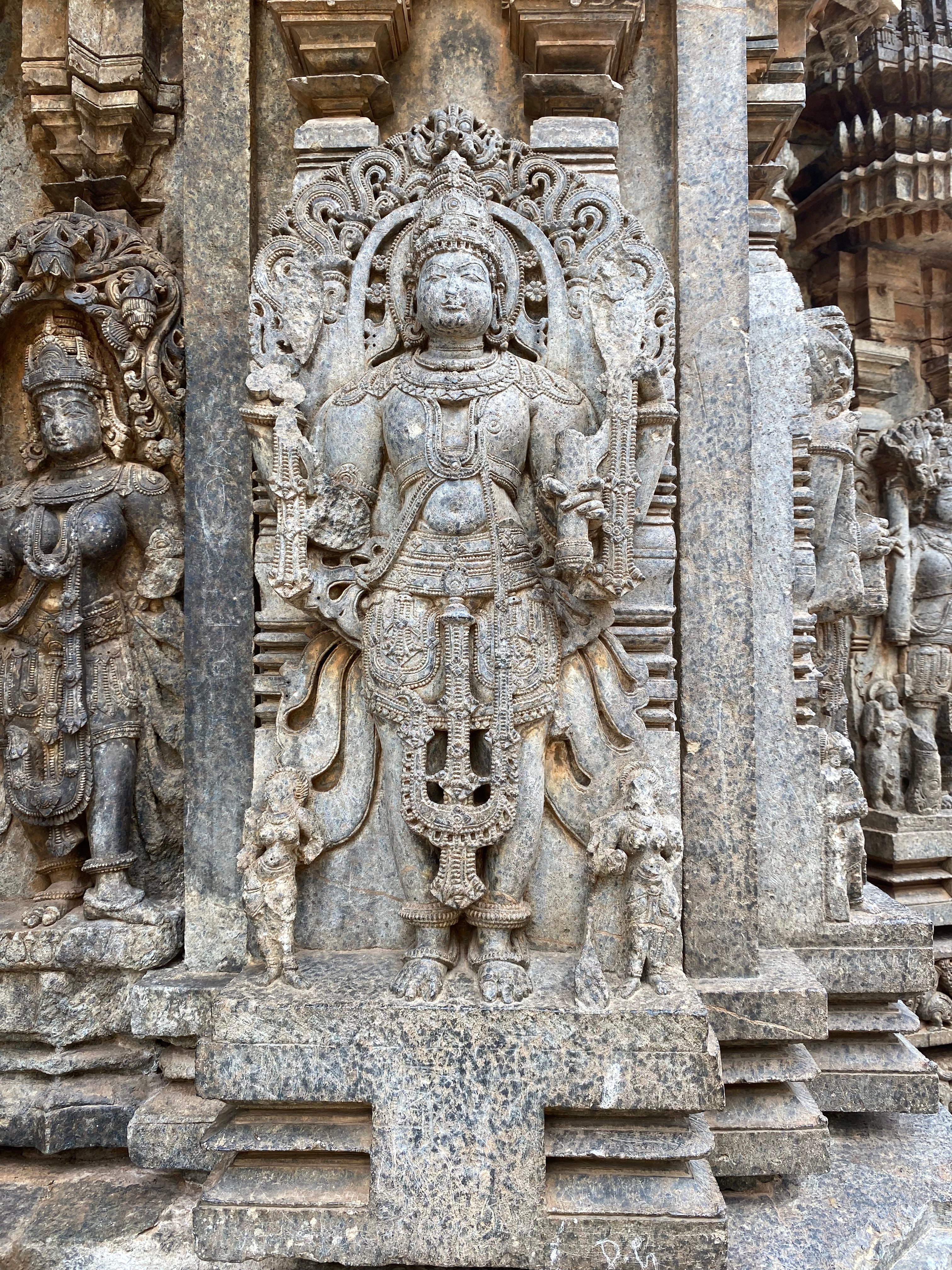 |
| 4 armed. All damaged |
47) Madhava
 |
| 4 armed. Each holding musala, chakra, shanka & padma. An inscription in nagari script can be seen on the pedestal |
48) Vishnu
 |
| 4 armed. Each holding Abhaya, chakra, shanka & varadamudra |
49) Dattatreya
 |
| 8 handed. 5 of which hold musala, padma ,dhanus, shanka & pustaka |
50) Brahma
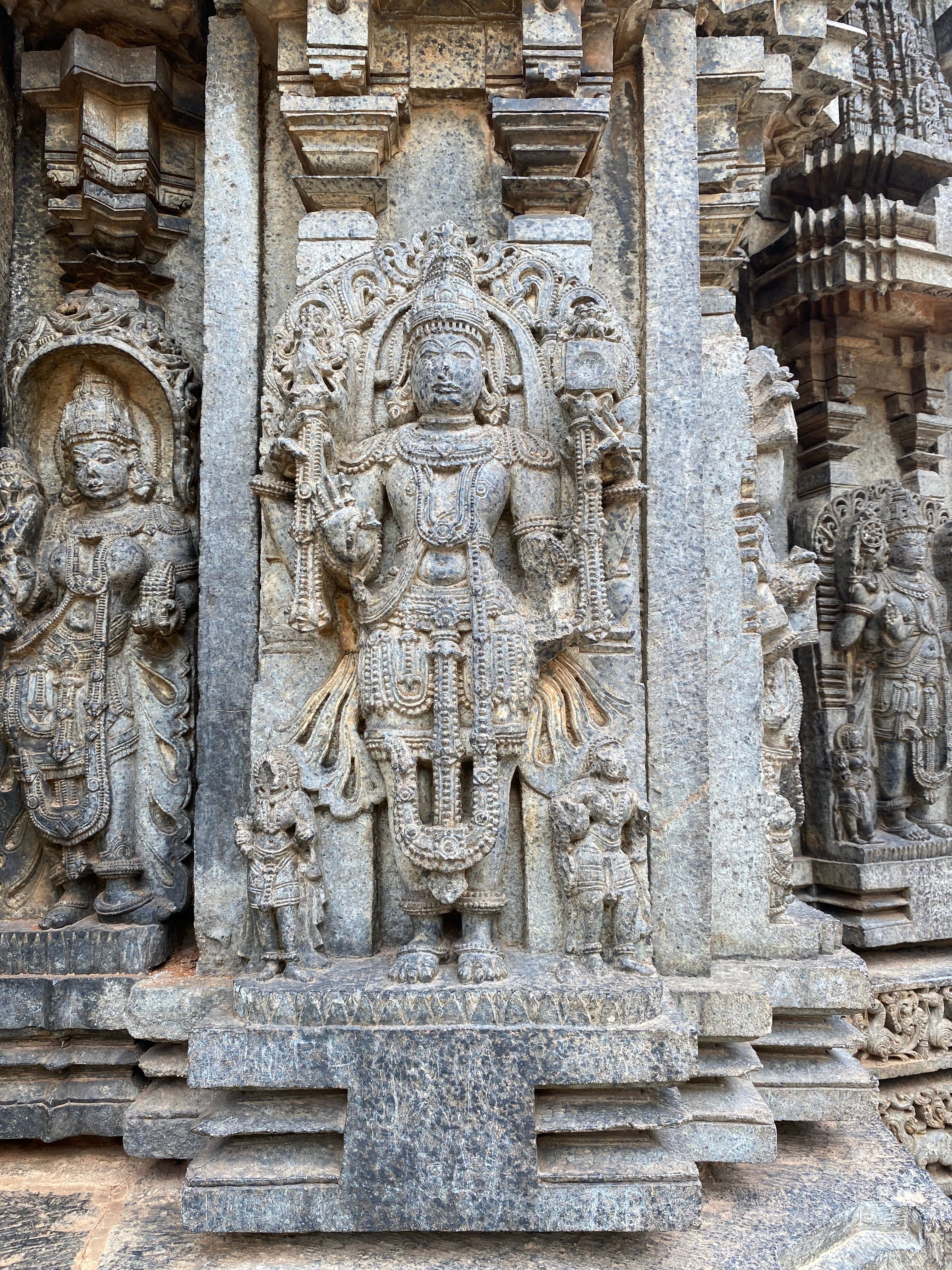 |
| Depicted without a beard. 4 armed. Each holding an akshamala, sruk, sruva (spoon). 4th arm is broken |
51) Venkateshwara
 |
| 4 armed. back hands broken. Front right arm in Abhayamudra & the left resting on the hip. |
52) Vishnu
 |
| 4 armed. Each holding spear, chakra, shanka & musala |
53) Madhava
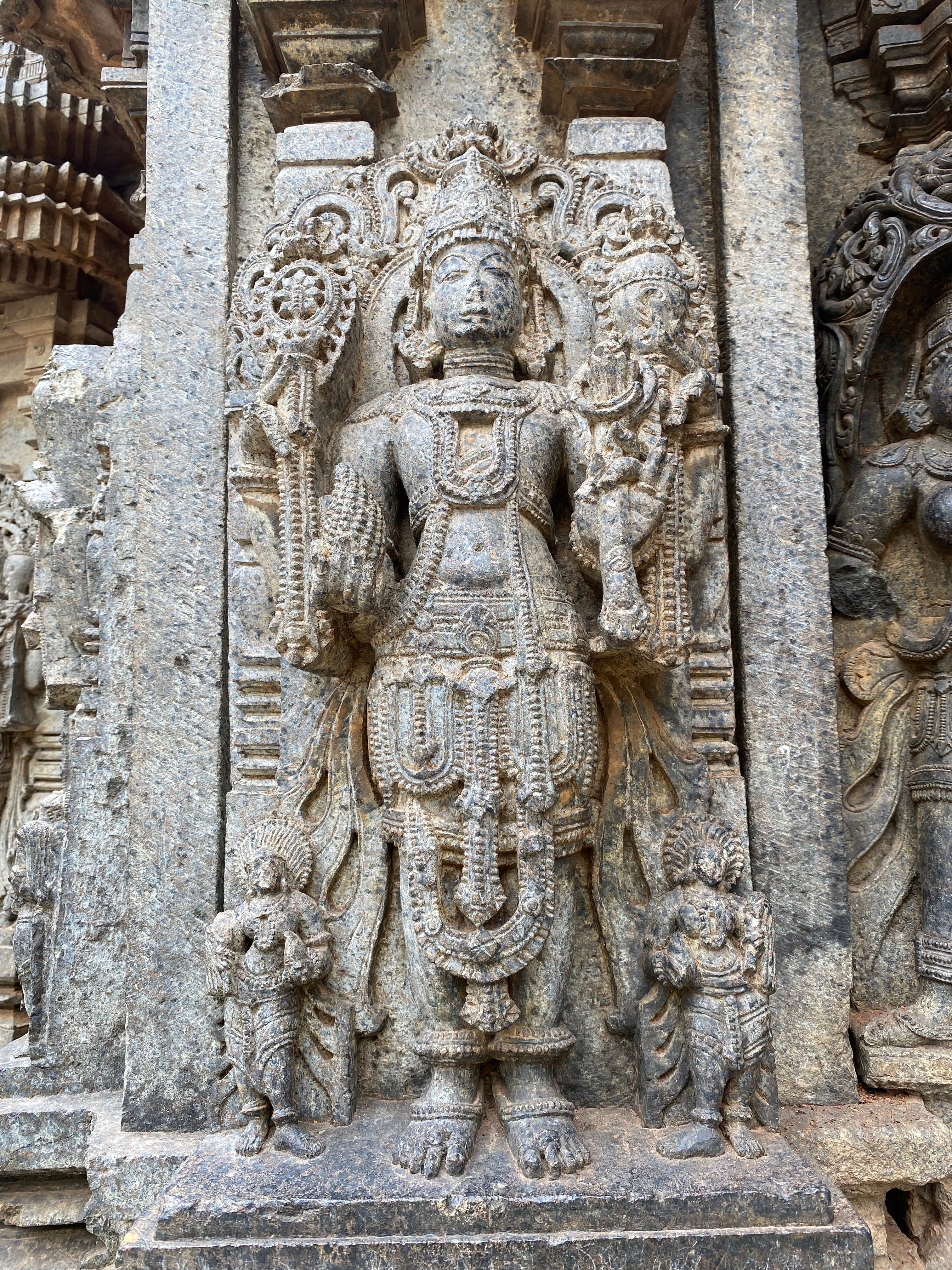 |
| 4 armed. Each holding phala, chakra, shanka, padma |
54) Yama
 |
| 4 armed. Each holding a Pasha (noose), chakra, shanka, vardhamudra. The sculptor of this image has been identified as Maarana. |
55) Madhava
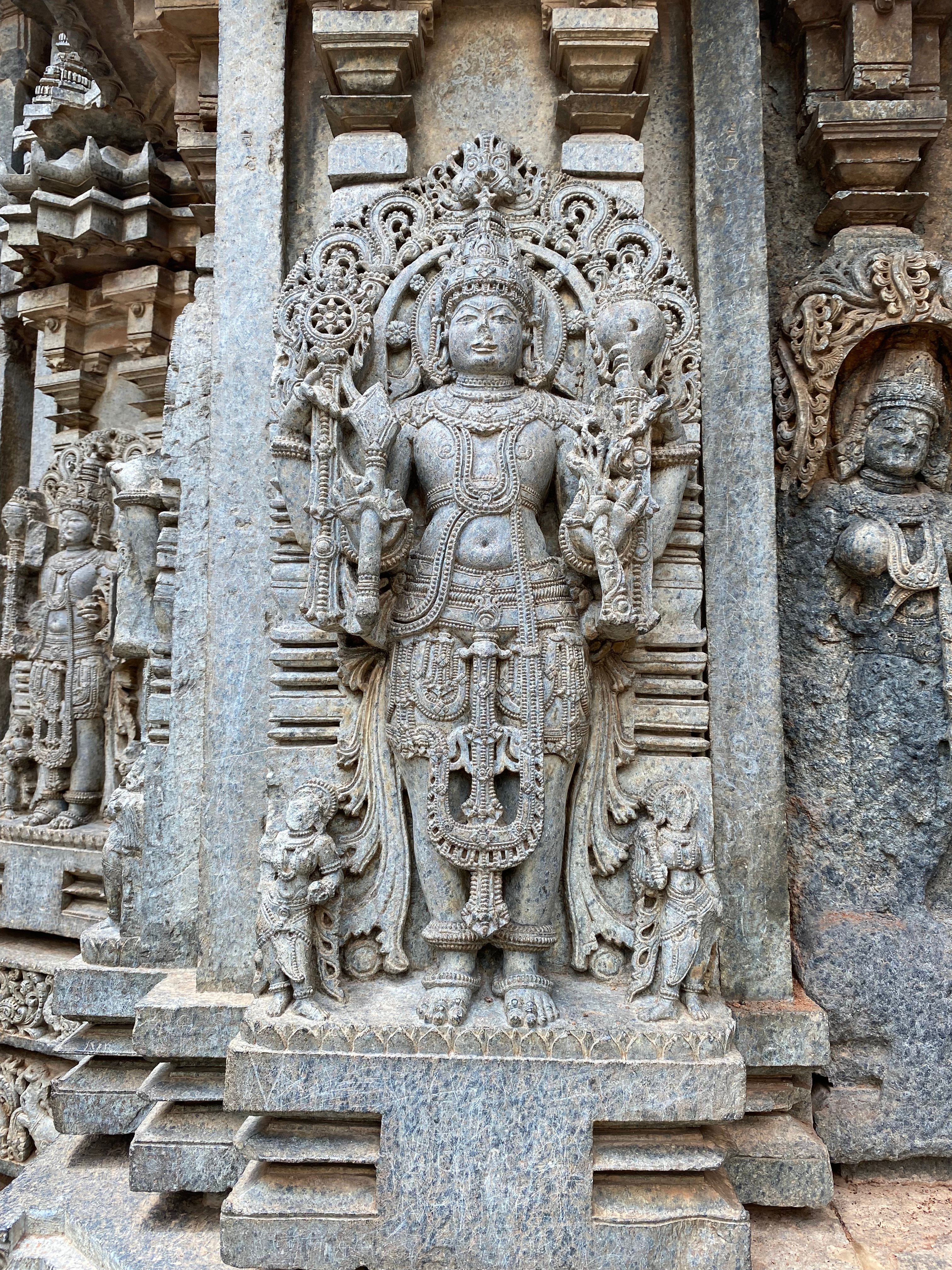 |
| 4 armed. Each holding a javelin, chakra, shanka & padma. |
56) Vishnu
 |
| 4 armed. Back arms broken. Front hands in Anjali |
57) Vishnu
 |
| 4 armed. Only Shanka visible |
58) Harihara
 |
| 8 armed. Only Gada visible |
59) Vishnu
 |
| 4 armed. Each holding chinmudra, chakra, shanka & paasa |
60) Vishnu
 |
| A rare form of Vishnu in dancing pose. He holds a Veena in with front arms. Chakra & Shanka with back arms |
61) Vishnu
 |
| Again in dancing pose with 8 hands, of which 3 are broken. Rest hold an akshamala, shanka, kalasha, lambahasta & 1 hand has 2 fingers raised. |
62) Vishnu
 |
| 4 armed. 3 arms broken. Only padma visible |
63) Manmatha
64) Vishnu
 |
| all arms broken. |
65) Lakshminarayana
 |
| Seated in Sukhasana with Garuda to the left (broken) and elephant near Lakshmi's feet. The sculptor of this image is Masanitamma |
66) Lakshmi
 |
| Seated with 4 hands each holding padma, chakra, shanka and phala |
67) Janardhana
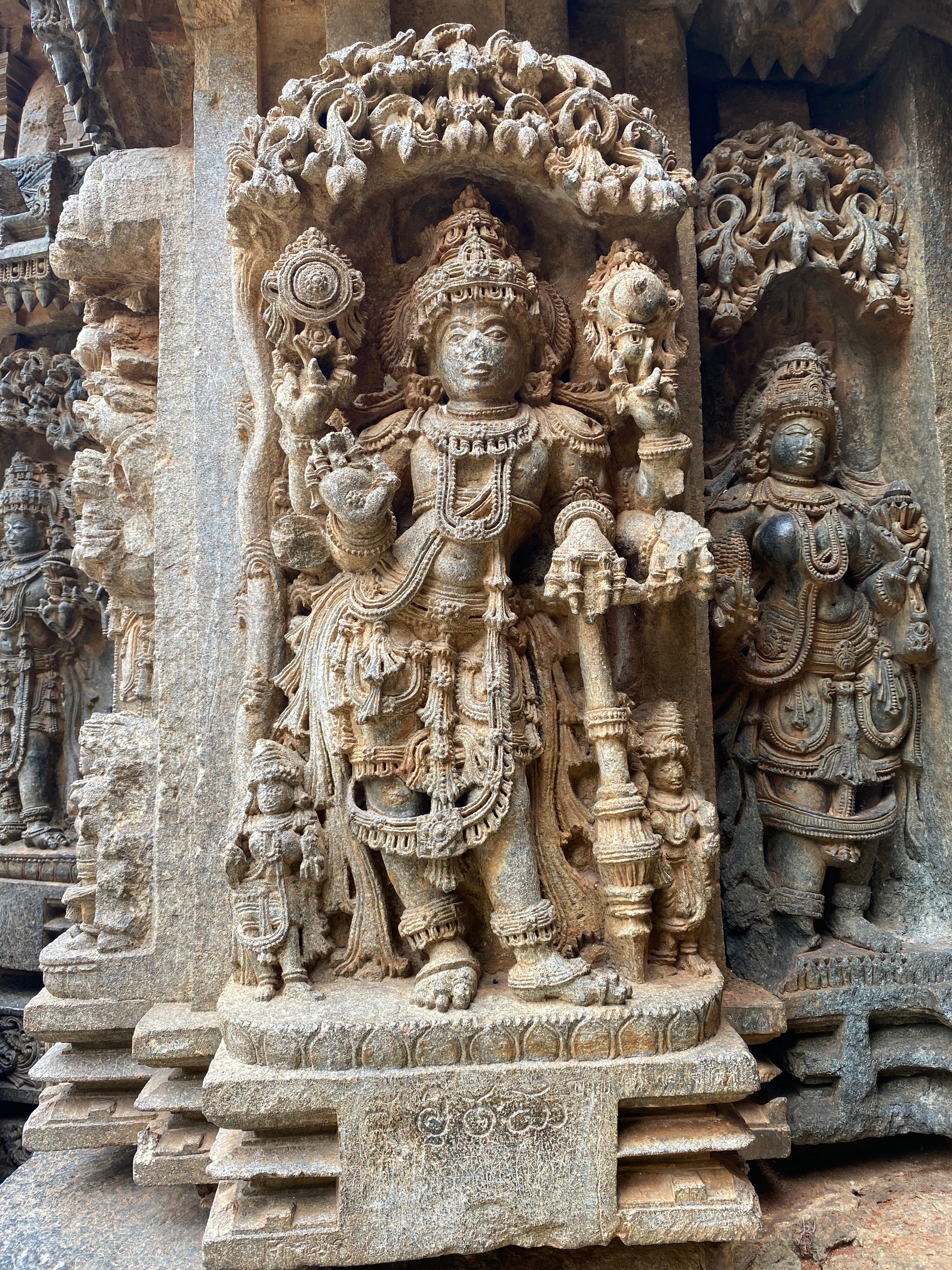 |
| 4 handed each holding abhayamudra, chakra, shanka & gada. Sculpted by Mallitamma |
68) Vishnu
 |
| 6 armed. Paasha, gada, shanka, and chakra visible |
69) Vishnu
 |
| 6 armed. Musala, 2nd right hand broken, shanka, chakra, shakti weapon & padma visible |
70) Vasudeva
 |
| 6 armed. Each holding Akshamala, gada, shanka, chakra, padma & phala |
71) Sankarshana
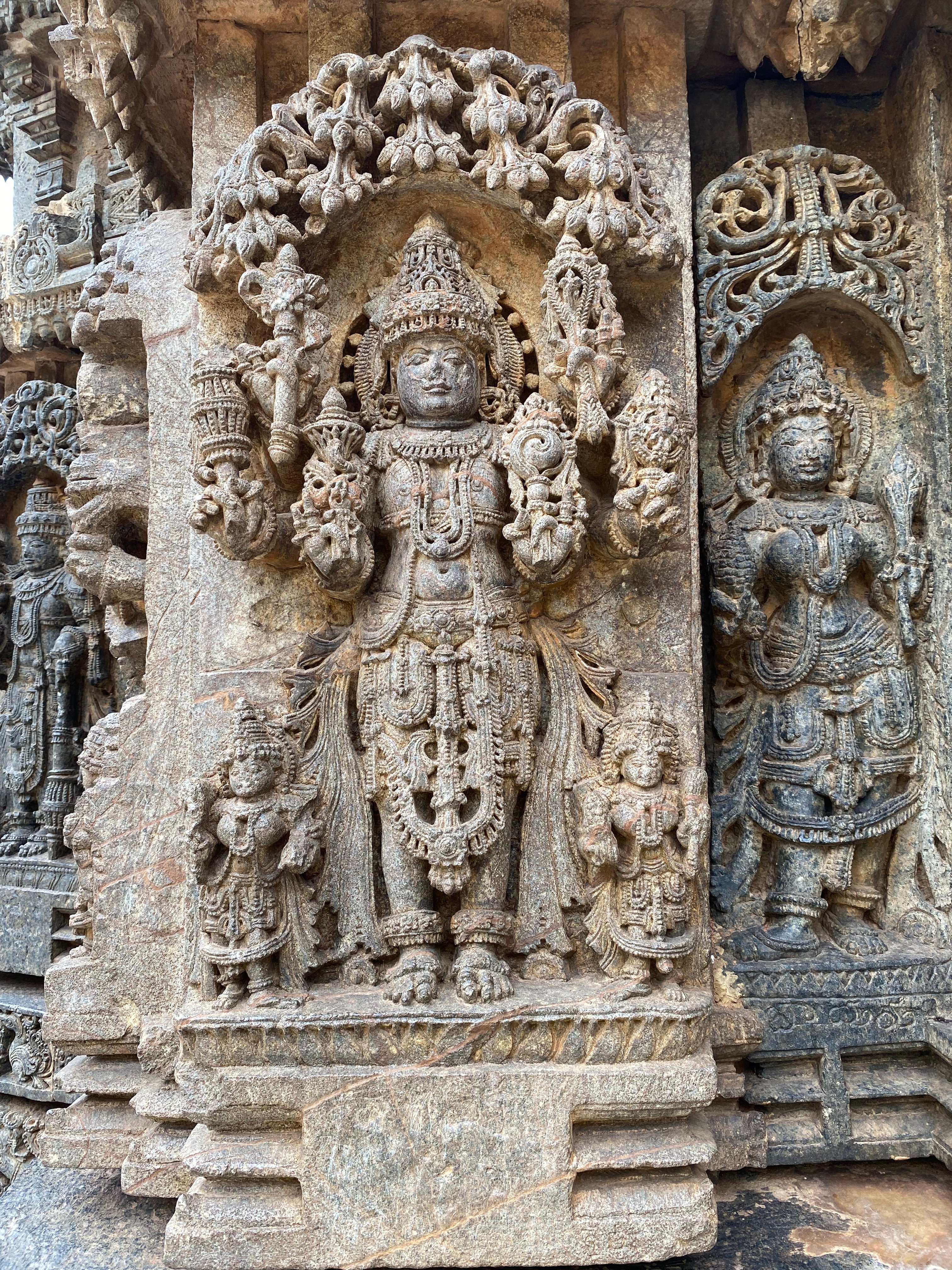 |
| 6 armed. Each holding padma, gada, hala, pasa, chakra & shanka |
72) Parashurama
 |
| 6 armed. Each holding shanka, gada, paasa, parashu, padma & chakra. The sculptor of this image is Chamiah |
73) Janardhana
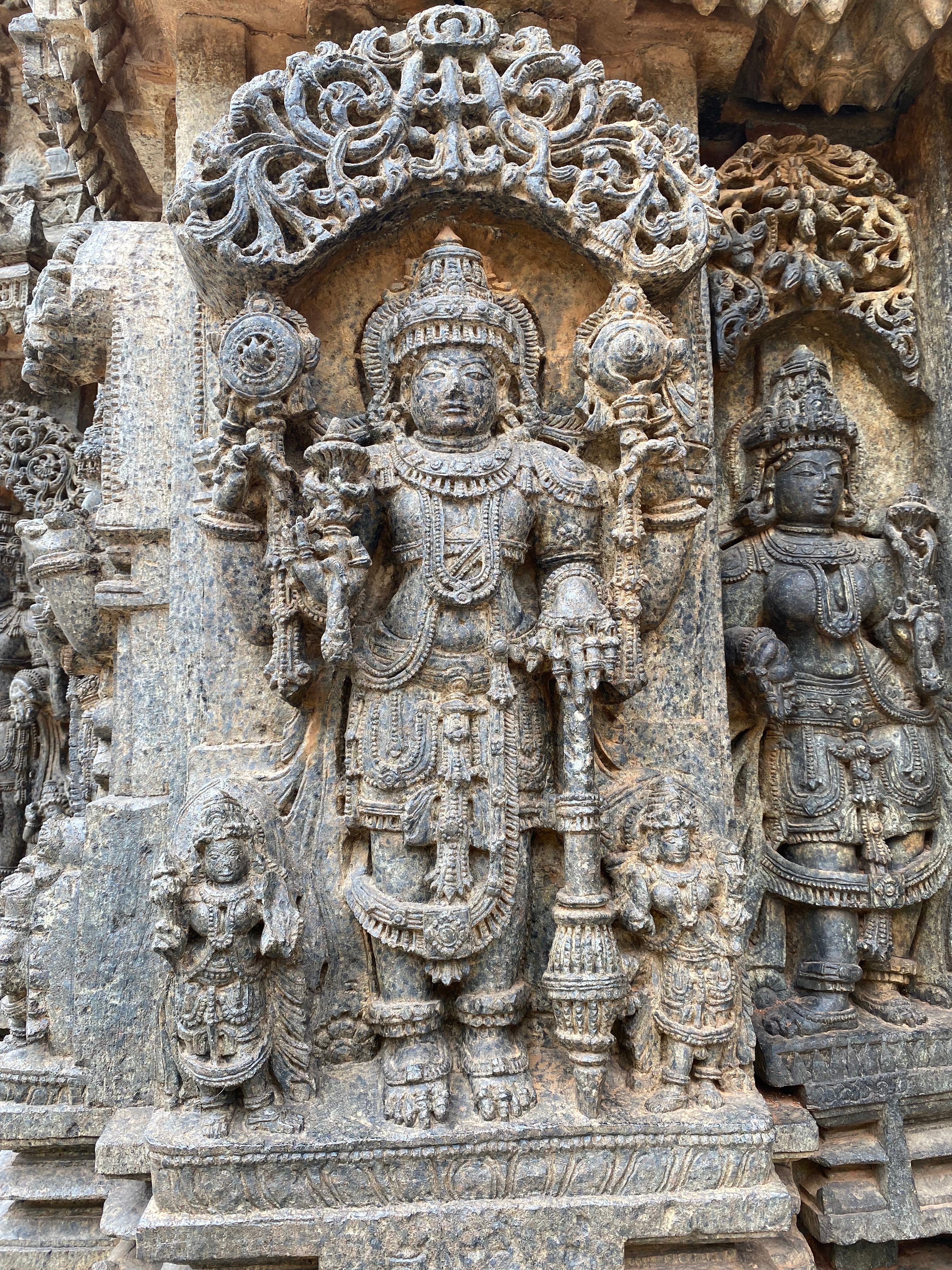 |
| Upper arms holding Chakra & Shanka. Lower arms holding Pushpa & Gada |
74) Hari
 |
| Vishnu wielding Gada, Shanka, Chakra (damaged), Pushpa |
75) Suryanarayana
76) Madhava
 |
| 6 hands. Each holding abhaya mudra, gada, chakra, shanka, padma & daana mudra |
77) Damodhara
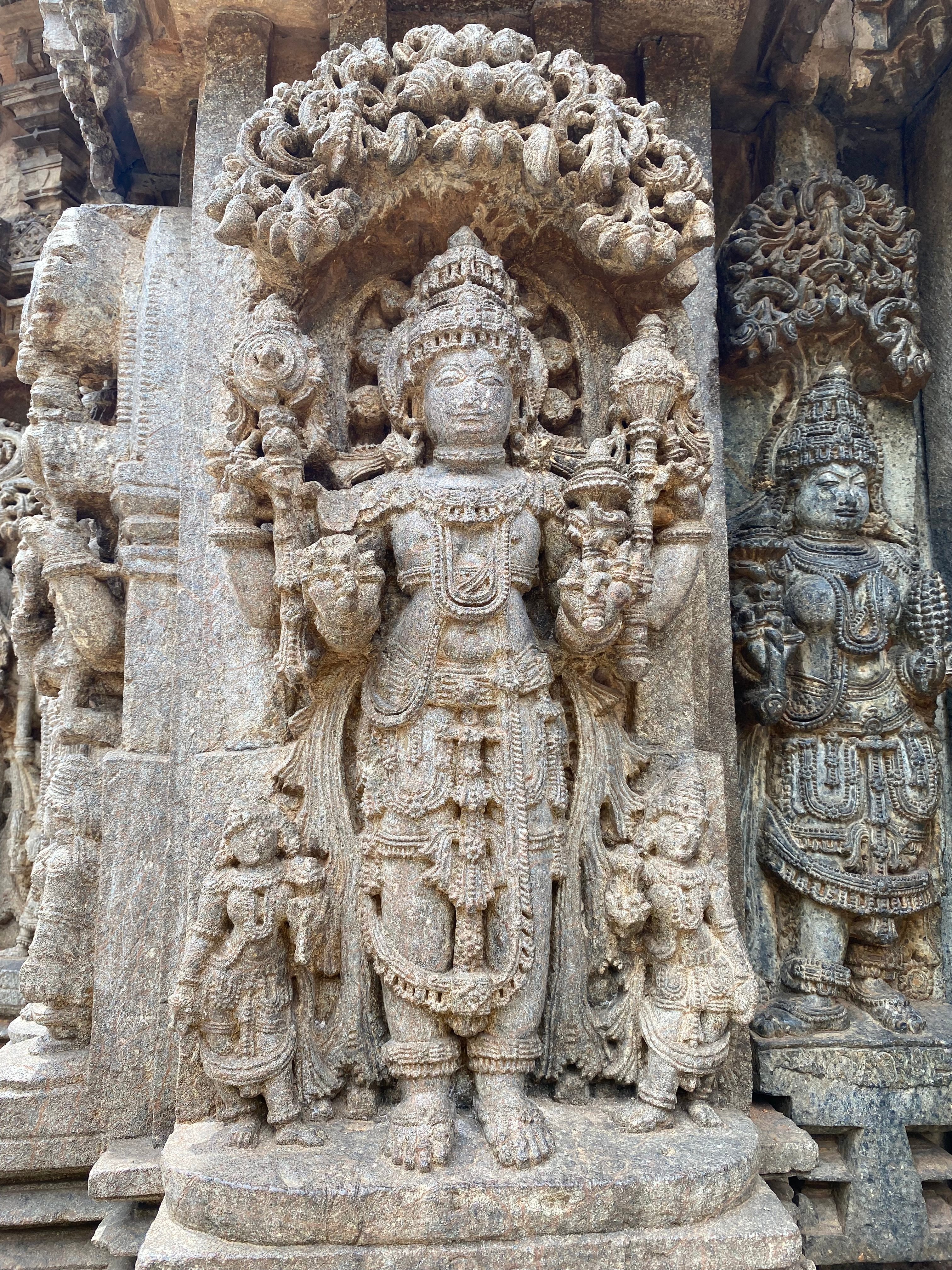 |
| 4 armed. Each holding Chakra (damaged), shanka, gada, padma |
78) Trivikrama
 |
| 4 armed. Each holding Pushpa, Gada, Chakra & Shanka |
79) Narayana
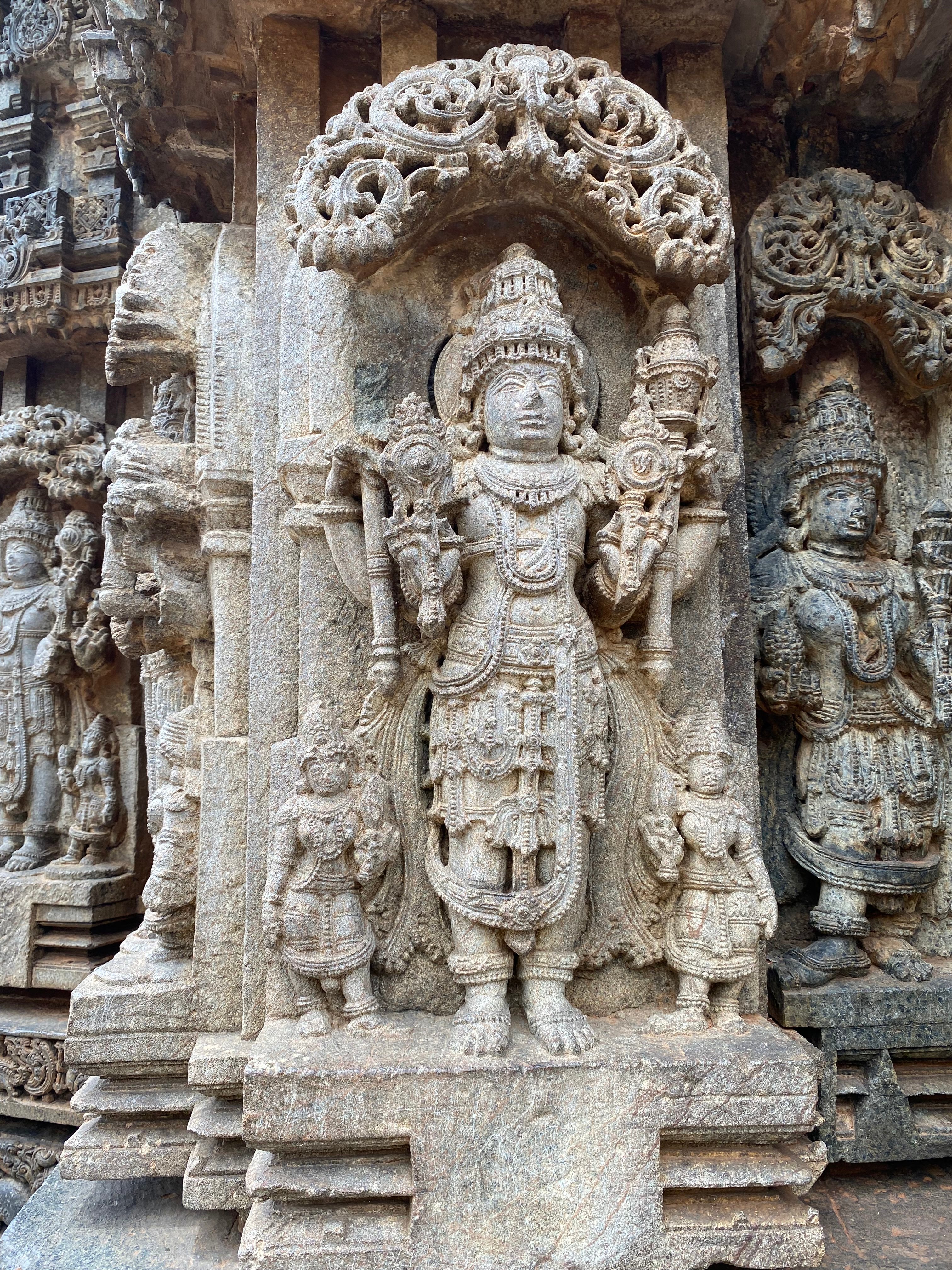 |
| 4 armed. Shanka, padma, gada, chakra are seen |
80) Janardhana
 |
| 6 armed. Each holding abhaya mudra, padma, chakra, shanka & phala |
81) Madhava
 |
| 6 armed. Abhaya, gada, chakra, shanka, padma & daana mudra seen |
82) Vishnu
 |
| 2 arms broken. Other 2 holding chakra & shanka |
83) Vishnu
 |
| 4 armed. Chakra, shanka & pustaka are seen |
84) Nritya Lakshmi
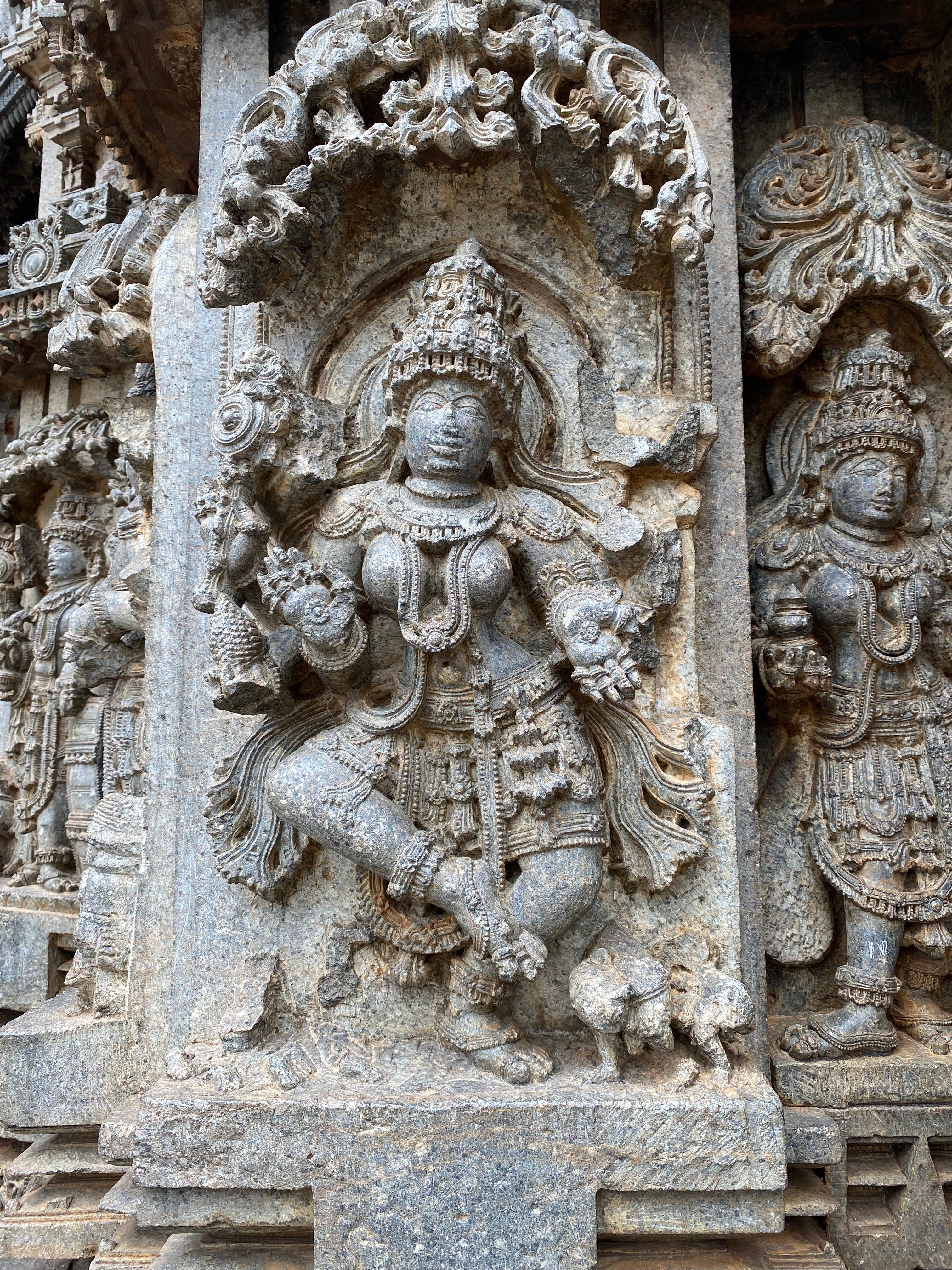 |
| 8 armed. Abhaya, phala, chakra & dana mudra visible. Rest are broken |
85) Vishnu
 |
| 6 armed. Chindmudra, padma, ankusha, daanamudra, two arms broken) Mallitama is the sculptor |
86) Kalki
 |
| 4 armed. Khadga (sword), chakra, shanka, kavacha (shield). Mallitama is the sculptor |
87) Mahishasuramardhini Durga
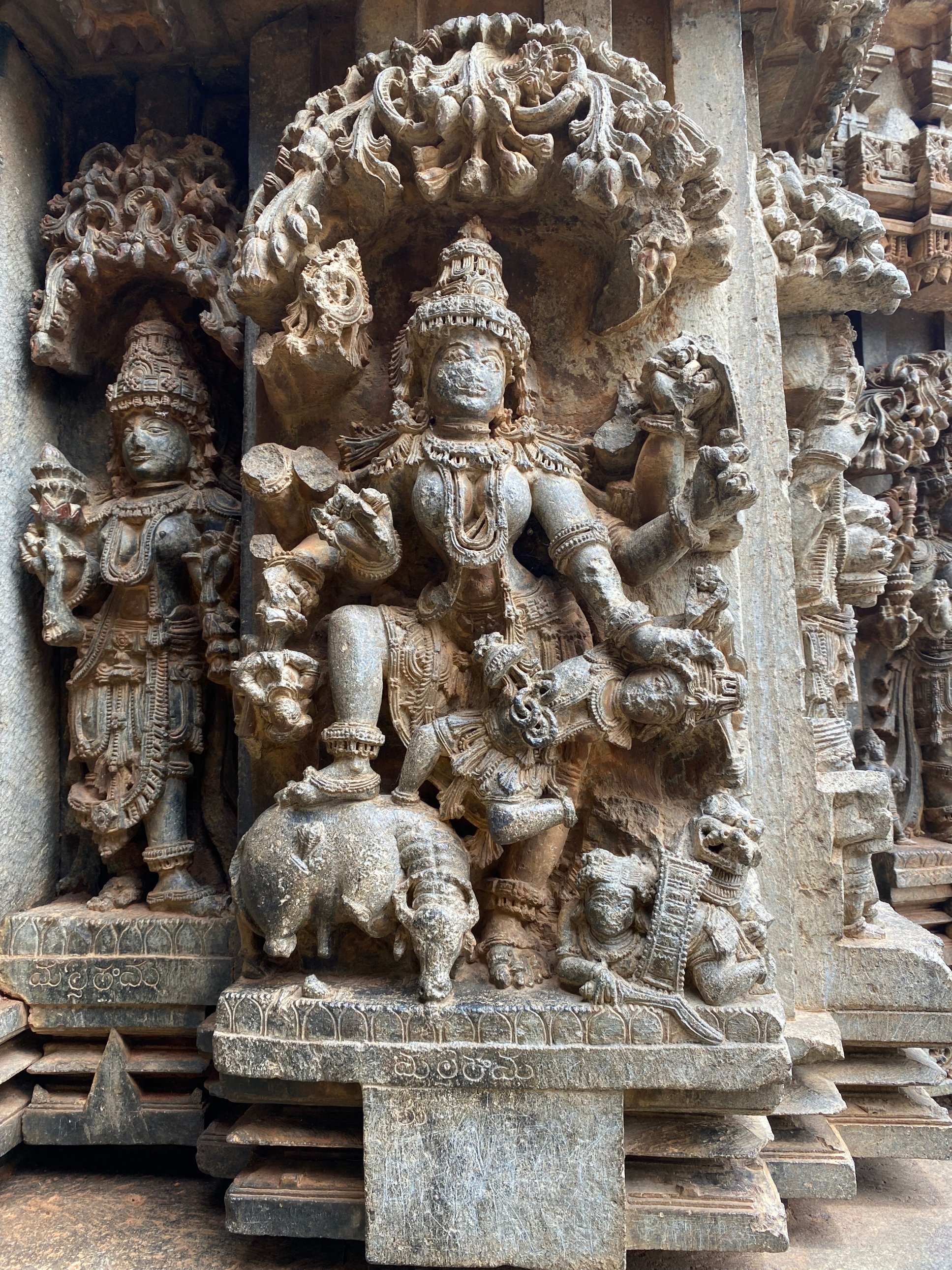 |
| 8 armed. Devi's left hand crushing mashisura's head. Sculpted by Mallitama |
88) Vishnu
 |
| 4 armed. Each holding Bana (arrow), paasha, chakra & shanka. Sculpted by Mallitama |
89) Devi
 |
| A 8 armed Devi in dancing posture. 6 arms damaged. 2 front arms holding Abhaya & Varadha mudra. Gandharvas playing mridanga & davane on either side. Sculptor is Mallitama |
PART II of this post can be read HERE

